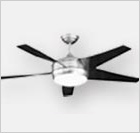Heating and Cooling
Air leakage
Air leakage is a major health and environmental problem for homes. It can
contribute up to 30% of cooling and heating costs, create comfort and
moisture problems, pull mold into buildings, and serve as an easy access
for insects. There are many ways to reduce the amount of conditioned air that is lost
and decrease the amount of energy spent to heat and cool your home:
Check for air leaks around windows and doors
Make a draft-checker by taping a piece of tissue paper to a metal
clothes hanger. On a windy day, while inside your home, hold the
draft-checker still at several places around the frames of windows and
doors. If the paper moves, then there is a leak. Carefully seal
cracks by recaulking or applying weather-stripping tape (PDF).

Programmable thermostats
You can schedule the time your heating/AC system operates. Your homes' programmable thermostat can store and repeat multiple daily settings. When the weather is warmer, raise the thermostat to 78°F. For every degree above 72°F, you will save 5% on cooling costs. When cooler outside, lower the thermostat to 68°F.

Ceiling fans
Ceiling fans give you the sensation that a room is cooler than it actually is by creating a breeze.
The thermostat can be moved to a higher temperature and you will still feel comfortable. Make sure to turn off the fan when leaving
the room. Fans do not actually cool the air, they just move it.
Passive cooling
Passive cooling is the process of cooling without mechanical means. The
most effective way to cool your home is to keep the heat from entering in the first place.
One method of passive cooling takes advantage of landscaping. Below are window and roofing options to save energy.

Windows
Windows can account for 10-25% of your home's heating bill. During the summer, windows make the AC work two to three times harder by letting in the sun's heat. There are measures you can take to reduce heat gain in your home:
- Install screens over all windows and doors so they can be left open for cross-ventilation.
- Add overhangs to the outside of windows to control the sun's direct radiation.
- Exterior shading devices such as awnings and shutters are very effective because they block direct sunlight and can reduce heat gain by 65%.
- Install shades, drapes, or blinds to reflect heat away from the house. Lighter colors, especially white, work best.
- Close curtains on the windows during the day to reduce solar gain. Reflective coatings also cut glare and reduced fading of drapes and furniture.
- Apply sun-control or reflective films on south-facing windows to reduce solar gain.
- If you plan on replacing single-pane windows, consider energy efficient double-paned ones. For more information check out the Florida Solar Energy Center.
Roofing materials
Energy savings are strongly influenced by the solar reflectance of the
roof materials. A recent study by Florida Power and Light showed that the
whiter (and more reflective) the roofing material, the lower a home's
energy bill. White metal or cement tile roofs can reflect more than 70% of
the sun's energy and also have the ability to cool quickly at night.
Instead of increasing the insulation of a roofing system, "white roofing"
can be used to reduce cooling energy consumption by increasing the amount
of heat that is reflected (instead of absorbed) by the roof of the
house.
If the need to replace your roof arises, consider using high reflective roofing materials or apply a light colored coating, such as white latex, over an existing roof.
For more information, check out this article: Roofs Reflect Better Savings (PDF).




